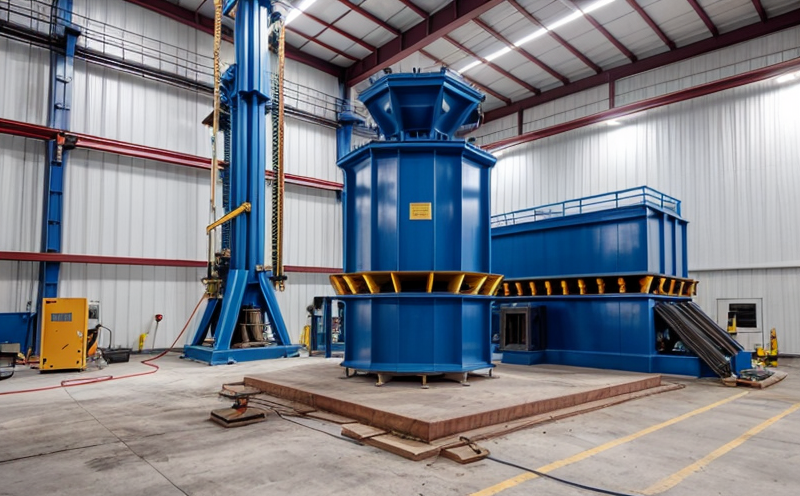ISO 7626-2 Experimental Modal Analysis Testing
The ISO 7626 series provides a comprehensive framework for experimental modal analysis (EMA), a key technique used in structural dynamics. This service specifically focuses on the second part of the ISO standard, which details the procedures and requirements for conducting EMA experiments. The goal is to identify and characterize the natural frequencies, mode shapes, and damping ratios of structures subjected to dynamic excitations.
The process begins with careful preparation of the specimen, ensuring it meets all dimensional and surface finish criteria specified in relevant standards like ISO 7626-1 for experimental modal analysis. The specimen is then excited using a controlled input force, which can be achieved through shakers or impact hammers. Careful selection of excitation frequency ranges ensures that the natural frequencies of interest are captured within the spectrum.
Key instrumentation includes accelerometers and displacement transducers attached to critical points on the structure. The data acquisition system records both the excitation force and response acceleration signals with high precision. Post-processing involves applying algorithms to extract modal parameters from these raw signals, adhering strictly to the guidelines outlined in ISO 7626-2.
The results are typically presented as a modal matrix containing all identified modes along with their associated frequencies, damping ratios, and mode shapes visualized through contour plots or displacement vectors. Compliance officers and quality managers can use this information for product certification and R&D purposes, ensuring that structures perform within specified limits under dynamic loading conditions.
Understanding the behavior of a structure during vibration is crucial for identifying potential issues before they lead to failures. This service supports various industries including automotive, aerospace, and manufacturing by providing detailed insights into structural integrity and performance. By adhering strictly to ISO standards, laboratories ensure reliability and consistency across different projects.
- Automotive manufacturers can use EMA results to optimize vehicle suspension systems for better ride quality and safety.
- In aerospace, modal analysis helps in designing lighter yet robust aircraft components that meet stringent durability requirements.
The service also supports R&D teams by offering deeper technical details on specimen preparation, instrumentation selection, data acquisition techniques, and advanced post-processing methods. Compliance officers can leverage this detailed information to ensure their products comply with international standards such as ISO 7626-2.
For procurement departments, the ability to compare test results against industry benchmarks becomes invaluable when selecting suppliers or designing new products. This service ensures that all parties involved have a clear understanding of what constitutes compliance and how it impacts final product design and performance.
Applied Standards
The ISO 7626 series, particularly ISO 7626-2 Experimental Modal Analysis Testing, is widely recognized in the structural dynamics community as a rigorous set of guidelines for conducting modal analysis experiments. This standard ensures that all tests are performed consistently and accurately across different laboratories around the world.
ISO 7626-1 provides background information on experimental modal analysis methodologies, while ISO 7626-2 focuses specifically on the procedures required to obtain reliable modal parameters from test data. Together, these two parts form a complete guide for performing accurate and reproducible EMA experiments.
The standard covers various aspects of experimental modal analysis, including:
- Selection of appropriate excitation methods
- Data acquisition techniques
- Signal processing algorithms used to extract modal parameters
- Reporting formats for presenting results
To ensure compliance with ISO 7626-2 Experimental Modal Analysis Testing, laboratories must adhere strictly to its requirements. This includes using calibrated instruments and following standardized procedures throughout the testing process.
The standard also emphasizes the importance of understanding the physical properties of the structure being tested, which influences how it responds to dynamic loading. By adhering closely to these guidelines, laboratories can produce reliable results that meet international standards and are accepted by regulatory bodies worldwide.
Industry Applications
The application of ISO 7626-2 Experimental Modal Analysis Testing extends across numerous industries where structural integrity is critical. Here are some key sectors:
- Aerospace: Ensuring that aircraft structures can withstand various types of dynamic loading without failure.
- Automotive: Optimizing vehicle suspension systems for better ride quality and safety.
- Machinery: Evaluating the durability and performance of industrial machinery under operational conditions.
- Bridges: Assessing bridge structures' ability to handle traffic loads safely over extended periods.
- Offshore Platforms: Monitoring offshore oil rigs for signs of fatigue that could lead to catastrophic failure.
- Military Equipment: Testing military vehicles and equipment for durability in harsh environments.
In each case, the primary goal is to ensure that structures perform reliably under dynamic loading conditions. By applying ISO 7626-2 Experimental Modal Analysis Testing, engineers can identify potential weaknesses early on, allowing for corrective actions before serious damage occurs.
Use Cases and Application Examples
Here are some practical use cases where ISO 7626-2 Experimental Modal Analysis Testing plays a crucial role:
- New Product Development: During the early stages of product design, EMA helps engineers understand how different materials and geometries affect structural performance.
- Problem Solving: When unexpected failures occur in field-deployed products, modal analysis provides valuable insights into what went wrong.
- Regulatory Compliance: Many industries are subject to strict regulations regarding product safety. EMA results can help demonstrate compliance with these standards.
- Cost Reduction: By identifying potential issues early in the design process, companies can avoid costly redesigns later on.
These examples illustrate just how versatile and valuable ISO 7626-2 Experimental Modal Analysis Testing is across various industries. The ability to accurately assess structural integrity through this method contributes significantly to overall product quality and safety.





